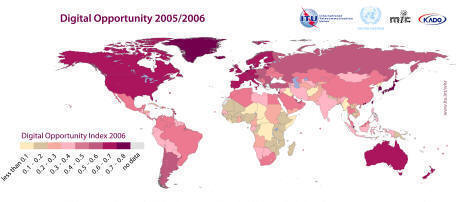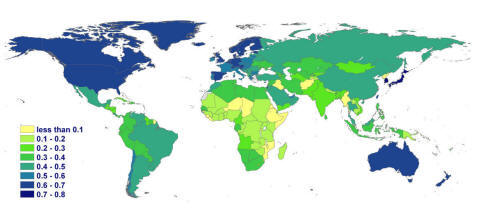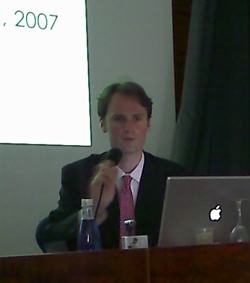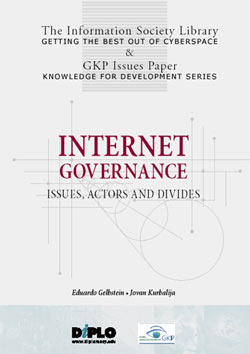The new International Journal of Information Communication Technologies and Human Development will see the light the first trimestre of 2009.
The journal is aimed at understanding how ICTs can contribute to human development in several areas. herefore its overall objectives are:
* To describe the link between ICTs and human development (which includes economic, social and political development).
* To identify the potential applications of ICTs in several areas.
* To provide insightful analysis about those factors (also contextual and institutional ones) that affect ICTs for development initiatives success or failure.
* To propose strategies (to both governments and international cooperation organizations) to move forward and to address future challenges.
The journal will be edited by Mila Gascó (Editor-in-Chief) and Manuel Acevedo and Barbara Fillip, among others, as associate editors.
I have (proudly) accepted to be on the editorial review board, that features people like David Keogh, Robin Mansell, Alemayehu Molla or Pippa Norris, to mention a few most familiar to me.
Reviewing articles or communications has always been one of the best experiences I’ve ever had: it’s difficult to quantify how much you’ll learn by reading other’s ideas and finding out their good points and their errors. Simply enlightening.
On December 5 and 6, 2006, the W3C Workshop on the Mobile Web in Developing Countries took place in Bangalore, India. Half a year has passed, but the conclusions still apply.
It is very important not to forget the real goal of providing ICT in developing countries. The point is not at all to connect people to the Web but to provide services (health, banking, government service, education, business,…) […] the most appropriate way to provide such e-services on mobile phones is with SMS-based applications. The reasons for that are numerous:
* Easy to use (everybody knows how to send an SMS)
* Low and predictable cost (no cost for receiving a message, low and known cost for sending a message)
* Availability on all phones
Of course, there is a general agreement on the limitations of such applications :
* Low capabilities (text-only, limited size, basic services like single query – answer, …)
* Interoperability problems between operators
Adopting the Web as the platform for developing future services requires work on these blocking factors which have been identified:
* Problems of availability of Web browser
* Problems of configuration
* User Interface
* Cost
That said, there is a general agreement that the Web is providing unique opportunities which may facilitate the bridging of the digital divide:
* a standardized platform to ease service development
* cheap service development and hosting
* large scope and wide audience
* easy reachability and “discoverability” of existing services (search engines, portals, …)
More info
The second edition of the World Information Society Report is out, bringing us a new calculation for the Digital Opportunity Index.
It’s a pity that the graphical representation of the Digital Opportunity Map has changed colors, as it makes it more difficult to compare among years. Nevertheless, here come both maps for 2006 and 2005 (remember that the report shows the DOI for the preceding year):

Digital Opportunity Index 2006. Source: World Information Society Report 2007
[click to enlarge]

Digital Opportunity Index 2005. Source: World Information Society Report 2006
[click to enlarge]
Major improvements — DOI increases above 20%, World Rank increases above 5 places (most of them are two digits increases) — are those of Antigua & Barbuda, Bangladesh, Barbados, Cambodia, Fiji, Guatemala, Lao P.D.R., Nicaragua, Palestine, Rwanda, St. Kitts & Nevis and Tanzania, reinforcing the trend of some Central America, Africa and Asia countries taking off and showing the path to other countries of the region with poor e-readiness results.
Getting worse — DOI decreases and loss of World Rank places —: Central African Republic, D.R. Congo, Madagascar, Turkmenistan and Zimbabwe, which as happened with the climbers, I think, sadly, does not surprise anyone.
Some other main conclusions are the huge strength of mobile telephony adoption in developing countries — in particular — and in the whole World — in general —, that makes coverage be almost universal and, thus, make the digital divide […] shrinking
. We’ve talked about this statement several times here, and luckily, this time the report warns about the danger that those infrastructures make broadband adoption more difficult than fixed lines, hence the availability and affordability of broadband remain a cause for concern
.
Actually, even if decreasing, inequality in digital development in the World (measured, for instance, through Internet usage) is still a major problem far to be solved and, if worst scenarios about broadband penetration come true, eager to get worse.
Robert Guerra kindly handed me three books back when we met in Sevilla. One of them was Internet Governance. Issues, Actors and Divides, by Jovan Kurbalija and Eduardo Gelbstein. As the authors themselves state, there are at least five dimensions to Internet issues: Infrastructure, Legal, Economic, Development, and Socio-cultural. Each one is discussed in the chapters that follow
.
Personally, I find the book really interesting and, honestly, much broader in scope and depth than an initial understanding of governance might bring to one’s mind. Actually, I’d compare it to Chris Nicol’s ICT Policy: A Beginner ’s Handbook as they share most of the aim, being Internet Governance. Issues, Actors and Divides more recent, and, indeed, going some steps further than Nicol’s. Both books make, in my opinion, a perfect pair to have a good overview — and something — on what is the Internet and how it does affect me. In other words: they both represent perfect e-awareness raisers.
Taking the book as a toolkit, and quoting again:
The main purpose of such an Internet Governance Toolkit would be to:
• organise the tools currently used in the Internet Governance debate;
• create additional cognitive tools;
• facilitate the inclusive nature of the Internet Governance process by providing interested parties with the tools to understand the issues, positions, and developments.
The Internet Governance Toolkit consists of:
• patterns and approaches;
• guiding principles;
• analogies.
 Perspectives associated with Internet Governance
Perspectives associated with Internet Governance
[image taken from the book]
Concerning the part of development and the digital divide, this table is of special interest to me:
ICT does NOT facilitate development:
• The “network externalities” help firstcomers establish a dominant position. This favours American giants so that local firms in emerging economies would be effectively frozen out of ecommerce.
• The shift in power from seller to buyer (the Internet inevitably gives rise to “an alternative supplier is never more than a mouse-click away” scenario) will harm poorer countries. It will harm commodity producers mainly from developing countries.
• Higher interest in high-tech shares in rich economies will reduce investor interest in developing countries.
ICT facilitates development:
• ICT lowers labour costs; it is cheaper to invest in developing countries.
• Very fast diffusion of ICT across borders occurs, compared to earlier technologies. Previous technologies (railways and electricity) took decades to spread to developing countries, but
ICT is advancing in leaps and bounds.
• The opportunity to leapfrog old technologies by skipping intermediate stages such as copper wires and analogue telephones encourages development.
• ICT’s propensity to reduce the optimal size of a firm in most industries is much closer to the needs of developing countries.
While the list is not complete, it does give some good hints on what is happening on the developing countries arena.
More info
I’m glad to announce…
yes, this is how this kind of things begin. This is quite a personal message, but I’m glad to announce that…
From July 16th to 28th, I will be at the Oxford Internet Institute Summer Doctoral Programme 2007, coorganized by and taking place at the Berkman Center of Internet and Society, in Cambridge, MA.
After leaving Cambridge I’ll be at Yale Law School and pay a visit to Eddan Katz and the Information Society Project, at New Haven, presumably on July 30th and 31st.
Besides those already scheduled events, I’m really eager to meet some other people — known or unknown — working on the field of ICT4D, the Digital Divide, Open Access and the Information Society in general and feeling like sharing a coffee. Ben Compaine — with whom I had an interesting discussion here and here — already stated his will to pay ;) one of those coffees. Anybody else interested, please let me know by commenting the message, through the contact section or just e-mailing me.
My flight plan begins landing on New York on July 13th and taking off from New York on August 2nd.
John Palfrey, Executive Director Berkman Center of Internet and Society, presents his seminar Born Digital at UOC headquarters, organized by the University’s UNESCO Chair in e-Learning.
John introduces his speech as a trip through some reflections that arise from the fact that some people (i.e. born in the middle eighties and on) have always lived with the Internet and digital technologies. Those people live/interact on digital landscapes that do have some specific characteristics.
 John Palfrey
John Palfrey
Digital landscape
Digital identities, in two senses. One is be present on the Internet. Second, to be able to shape one’s identity at one’s will, as the Internet allow one to.
Multi-tasking: lots of windows open and things being done at the same time
Digital media: all your stuff is created in digital form (you might never ever print it) and it can be mixed, edited, changed… mashed up, and it will stand this way, digitally. And, indeed, is not only digital media, but digital platforms. And even if they are at a very early stage, there is already now a new layer above traditional http that is working as a new means of digital communication. This layer is shaped by devices like Second Life, Flickr, RSS or the Wikipedia.
From consumers to creators: Of course, this mashing up involves changes in cultures, intellectual property problems… new challenges arcane for digital immigrants, not to say analogue citizens.
New technologies/features: Google Docs, AJAX, tagging, hackability, wikis, social networks, RSS. RSS surely made Web 2.0 go from just a cool idea to a big change in the state of things.
Lightweight collaboration: multiple users on distributed workgroups where people collaborate as long and as intensively as they want to. In Yochai Benkler’s words, is a democratising innovation.
An international perspective: New contexts and new meanings. People like (and also expect) commenting others’ reflections. Tagging and geotaggin provide, again, new contexts for content. And those contexts are most of them relying on a new concept of trust, which enables strong networks… and business models.
Addressing perceived threats
Security and safety: cyberbulling
Privacy: everything on the Internet is public… anyone lost a job offer because of sensible photos on the net? unintended audience, replicability, persistence, searchability, unintentional contributions.
- Tier 1: our own profile. You got control over what you post, and you can configure your own privacy settings.
- Tier 2: your friend’s profile. Friends upload a photo of yours and you untag it, removing any liaison to you.
- Tier 3: Blogs, Flickr, social networks. Friends upload a photo and you have to ask for them to remove it.
- Tier 4: facial recognition systems. Friends upload a photo of you and tehc tags it for them with face recognition (Riya). How to undo this?
Intellectual property: people creating new things from old things is increasing (as it is increasingly easy) and the perspective is that intellectual property rights issues (i.e. lawsuits) are going to be a big issue in the nearest future (present!).
Information expectations:
- credibility: “hidden influences”, grazing, misinformation… are common on wikis and blogs
- information overload
Positive outlook
So, what’s the agenda from now on?
media literacy skills, expression/identity, empowering creators, information sharing, maintaining connections
Opportunities: creativity, media literacy, social production, semiotic democracy
Blogs and Wikis: knowledge creating, equity/democratic, participatory, empowering individuals, autonomy, cross-cultural and community building
Opportunities: Information creation, semiotic democracy, participatory, empowering individuals, access to information
 John Palfrey
John Palfrey
To end, John briefly presents digitalnative.org:
An academic research team — joining people from the Berkman Center for Internet & Society at Harvard Law School and the Research Center for Information Law at the University of St. Gallen in Switzerland — is hosting and working on the core of this wiki, which illustrates the beginning stages of a larger research project on Digital Natives.
“Digital Natives” are those people for whom the internet and related technologies are givens, whereas “Digital Immigrants” migrated to these technologies later in life (Prensky, 2001). Digital Immigrants know how life existed in the pre-networked society, whereas Digital Natives take networked communication as the foundation of their lives.
The focus of this research is on exploring the impacts of this generational demarcation. By learning as much as we can about Digital Natives, their way of life, and their way of thinking, we can address the issues their digital practices raise, and shape our legal, educational, and social institutions in a way that supports and protects natives, while harnessing the exciting possibilities their digital fluency presents.
Questions
Challenging question by Max Senges: is it possible to live with several identities at the same time? John thinks that no and, in the end, identities seem to converge on your real one, and your blog or whatever sooner or later reflects who you really are.
An interesting circle is being created: technologists create technology based on expected market users, but the users reshape this technology by using it, and again, technologists re-reshape the technology and so on. How can this be controlled, managed, etc.
César Córcoles: digital identity (on intensive live online) will become something normal, but now it is seen as (a) geekery (b) a bad thing to do (lost of time), so what should we, as academics, do? John answers that, actually, the problem is that academics are also digital immigrants, and thus they first have to learn. Open Access might be a good way to legitimate new means of distributing content and from an academic basis or point of view. (Academic) blogging is still not very popular, but how to foster it?
Ana Zúñiga: about information overload, the problem sometimes is that there is a strong lack of digital literacy, specially informational literacy, so you know where to go to in order to get high quality information.
Cristina Girona and John (and many others) engage in a debate about not using technolgy by itself, but for final purposes, such as educational purposes. But there is a need not only to think about technology in classrooms, but also to think about teaching itself.
Emma Kiselyova excellently points the fact that digital immigrants will disappear with time and digital natives will, sooner or later, rule the world. In the meanwhile, in the impasse, what should be done? How can educational institutions make the bridge, lead the rupture that digital technologies are causing.
I point, following Emma’s line, that all in all is a matter of e-awareness, of knowing what this digital paradigm means for everyone of us. On one side we’ve got digital immigrants (DIs; I here also include digital outsiders), that as mature people as they are, they have some degree of awareness of things (of what means living, how society works, what is moral and what is ethics, etc.) but have poor knowledge of “e-” things. On the other side, there’re digital natives (DNs), that fully master the “e-” part but they need education (remember: they’re still young and “inexpert”) and a place to go (i.e. the University) in order to get some awareness. But nobody is actually crossing the line to make ends meet: DIs do not approach digital landscapes and DNs, actually, pass over traditional knowledge that brings awareness (the example of intellectual property rights infringement is crystal clear).
Silvia Bravo argues that an approach is really happening, that the academy is blogging and writing on wikis. In my opinion, even if this was true (which I honestly believe it is not, at least not with a critical mass), the problem is that individuals are not the ones who transmit values, but institutions. And, at the institutional level, the state of things is definitely distressing.
See also:



 Full Report
Full Report



